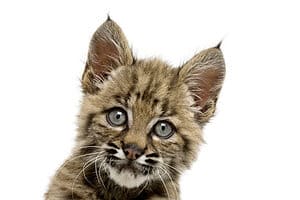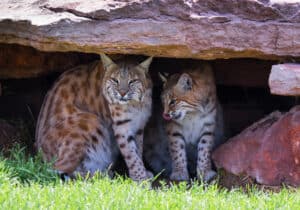The bobcat population is rising in North Carolina at an astonishing rate. Experts have noted that since 2010, the population in North Carolina has exceeded 100,000. These stealthy predators are so fast and quiet, that we rarely see them. And yet, more and more people in North Carolina are encountering these medium-sized cats.
We will discuss bobcats in North Carolina including where they live, what they eat, and some unique facts about them.

Bobcats look like housecats at first glance but are larger with short tails and distinctive ears.
©gobirdnerds/Shutterstock.com
About Bobcats in North Carolina
At first glance, bobcats look a lot like regular domestic cats, and yet there are distinct differences. For instance, bobcats are almost twice as big as domestic cats. Female bobcats grow between 28 to 32 inches long and weigh about 15 to 30 pounds. Male bobcats, on the other hand, can reach past 37 inches long and 35 pounds. They are curious creatures and yet they stay away from loud and crowded areas. Bobcats are best known for their short “bobbed” tail, which is all most people see since they run so quickly. They also have long legs and fluffy fur that surrounds their face, making them look wild.

Female bobcats grow between 28 to 32 inches long and weigh about 15 to 30 pounds.
©Laurie E Wilson/Shutterstock.com
Where do Bobcats Live in North Carolina?
If you want to spot a bobcat, North Carolina is a good place to start, however, these cats are stealthy and hide well. Bobcats are not picky animals, instead, they make their home almost everywhere including plains, mountains, and swamps. In North Carolina, these large felines can be found in bottomland hardwoods and young pine stands. They are more commonly spotted in eastern North Carolina. However, you can see them in western North Carolina where the region is mountainous and includes the Appalachian Mountains. If you decide to take a trip to the Appalachian Mountains in North Carolina, you might also spot elk, foxes, black bears, and groundhogs.

Bobcats are commonly spotted in eastern North Carolina.
©iStock.com/twildlife
How Many Bobcats Are in North Carolina?
According to a study published in the Journal of Fish and Wildlife Management, there are about 126,000 bobcats in North Carolina and the population is increasing. Recently, more confirmed sightings have been recorded. In the world, there are thought to be a little more or less than 1,000,000 bobcats in the wild.
What Do Bobcats Eat?
Bobcats are carnivores and use their instincts, excellent hearing, and sight to hunt for their prey. Since they are one of the smallest feline predators, they mainly eat rodents like rats and mice. However, they also hunt for rabbits and squirrels. Bobcats are unique animals and only require two to three hours of sleep every night. Their dens are usually in a wooded forest or a hollow tree. Sometimes, they have more than one den in the same area. They also heavily rely on their eyes since they hunt at night.
Although bobcats typically eat small mammals and prey, they have been reported to attack sharks. While it is rare, larger adult bobcats will attack stray dogs and feral cats, but it’s usually out of self-defense. Baby bobcats, also called kittens, don’t hunt for food until they are older. Instead, they exclusively drink their mother’s milk until they are about two months old. Then, they are slowly weaned off of milk and eat the food their mother brings.

Bobcat kittens rely on their mother’s milk for nutrition until they are two months old.
©Bildagentur Zoonar GmbH/Shutterstock.com
What Attracts Bobcats to Your Yard?
Bobcats usually ignore neighborhoods, but on occasion, they wander into someone’s yard looking for food. Since bobcats typically eat squirrels and mice, they may appear close to your home at night. It’s not always possible to avoid this. You can install a fence to keep them from coming in, but bobcats are known to jump up to 12 feet in the air.
If you see a bobcat in your yard, don’t worry. Bobcat attacks are rare. For such fierce felines, they are quite timid. However, if you do spot one, walk away slowly without turning around. While it’s tempting to run away, this could cause the bobcat to chase you, as its hunting instincts kick in. If they don’t leave right away and your pet is outside, it’s best to spray the bobcat with a hose. However, bobcats won’t attack animals larger than themselves unless they feel threatened.
The photo featured at the top of this post is © Victor Arita/Shutterstock.com
Thank you for reading! Have some feedback for us? Contact the AZ Animals editorial team.






